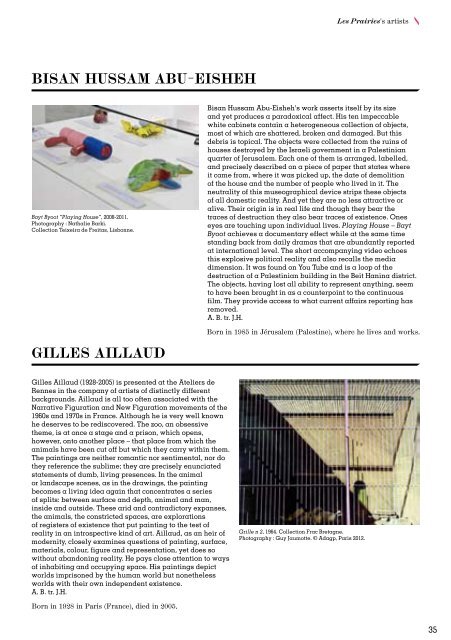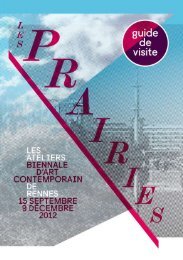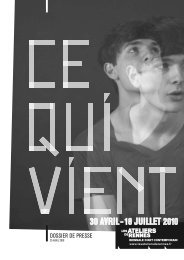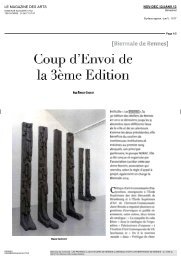Download here the Visitor's guide. - Les Ateliers de Rennes
Download here the Visitor's guide. - Les Ateliers de Rennes
Download here the Visitor's guide. - Les Ateliers de Rennes
Create successful ePaper yourself
Turn your PDF publications into a flip-book with our unique Google optimized e-Paper software.
BISAN HUSSAM ABU-EISHEH<br />
Bayt Byoot “Playing House”, 2008-2011.<br />
Photography : Nathalie Barki.<br />
Collection Teixeira <strong>de</strong> Freitas, Lisbonne.<br />
GILLES AILLAUD<br />
Gilles Aillaud (1928-2005) is presented at <strong>the</strong> <strong>Ateliers</strong> <strong>de</strong><br />
<strong>Rennes</strong> in <strong>the</strong> company of artists of distinctly different<br />
backgrounds. Aillaud is all too often associated with <strong>the</strong><br />
Narrative Figuration and New Figuration movements of <strong>the</strong><br />
1960s and 1970s in France. Although he is very well known<br />
he <strong>de</strong>serves to be rediscovered. The zoo, an obsessive<br />
<strong>the</strong>me, is at once a stage and a prison, which opens,<br />
however, onto ano<strong>the</strong>r place – that place from which <strong>the</strong><br />
animals have been cut off but which <strong>the</strong>y carry within <strong>the</strong>m.<br />
The paintings are nei<strong>the</strong>r romantic nor sentimental, nor do<br />
<strong>the</strong>y reference <strong>the</strong> sublime; <strong>the</strong>y are precisely enunciated<br />
statements of dumb, living presences. In <strong>the</strong> animal<br />
or landscape scenes, as in <strong>the</strong> drawings, <strong>the</strong> painting<br />
becomes a living i<strong>de</strong>a again that concentrates a series<br />
of splits: between surface and <strong>de</strong>pth, animal and man,<br />
insi<strong>de</strong> and outsi<strong>de</strong>. These arid and contradictory expanses,<br />
<strong>the</strong> animals, <strong>the</strong> constricted spaces, are explorations<br />
of registers of existence that put painting to <strong>the</strong> test of<br />
reality in an introspective kind of art. Aillaud, as an heir of<br />
mo<strong>de</strong>rnity, closely examines questions of painting, surface,<br />
materials, colour, figure and representation, yet does so<br />
without abandoning reality. He pays close attention to ways<br />
of inhabiting and occupying space. His paintings <strong>de</strong>pict<br />
worlds imprisoned by <strong>the</strong> human world but none<strong>the</strong>less<br />
worlds with <strong>the</strong>ir own in<strong>de</strong>pen<strong>de</strong>nt existence.<br />
A. B. tr. J.H.<br />
Born in 1928 in Paris (France), died in 2005.<br />
Grille n°2, 1964. Collection Frac Bretagne.<br />
Photography : Guy Jaumotte. © Adagp, Paris 2012.<br />
<strong>Les</strong> Prairies's artists<br />
Bisan Hussam Abu-Eisheh's work asserts itself by its size<br />
and yet produces a paradoxical affect. His ten impeccable<br />
white cabinets contain a heterogeneous collection of objects,<br />
most of which are shattered, broken and damaged. But this<br />
<strong>de</strong>bris is topical. The objects were collected from <strong>the</strong> ruins of<br />
houses <strong>de</strong>stroyed by <strong>the</strong> Israeli government in a Palestinian<br />
quarter of Jerusalem. Each one of <strong>the</strong>m is arranged, labelled,<br />
and precisely <strong>de</strong>scribed on a piece of paper that states w<strong>here</strong><br />
it came from, w<strong>here</strong> it was picked up, <strong>the</strong> date of <strong>de</strong>molition<br />
of <strong>the</strong> house and <strong>the</strong> number of people who lived in it. The<br />
neutrality of this museographical <strong>de</strong>vice strips <strong>the</strong>se objects<br />
of all domestic reality. And yet <strong>the</strong>y are no less attractive or<br />
alive. Their origin is in real life and though <strong>the</strong>y bear <strong>the</strong><br />
traces of <strong>de</strong>struction <strong>the</strong>y also bear traces of existence. Ones<br />
eyes are touching upon individual lives. Playing House – Bayt<br />
Byoot achieves a documentary effect while at <strong>the</strong> same time<br />
standing back from daily dramas that are abundantly reported<br />
at international level. The short accompanying vi<strong>de</strong>o echoes<br />
this explosive political reality and also recalls <strong>the</strong> media<br />
dimension. It was found on You Tube and is a loop of <strong>the</strong><br />
<strong>de</strong>struction of a Palestinian building in <strong>the</strong> Beit Hanina district.<br />
The objects, having lost all ability to represent anything, seem<br />
to have been brought in as a counterpoint to <strong>the</strong> continuous<br />
film. They provi<strong>de</strong> access to what current affairs reporting has<br />
removed.<br />
A. B. tr. J.H.<br />
Born in 1985 in Jérusalem (Palestine), w<strong>here</strong> he lives and works.<br />
35






